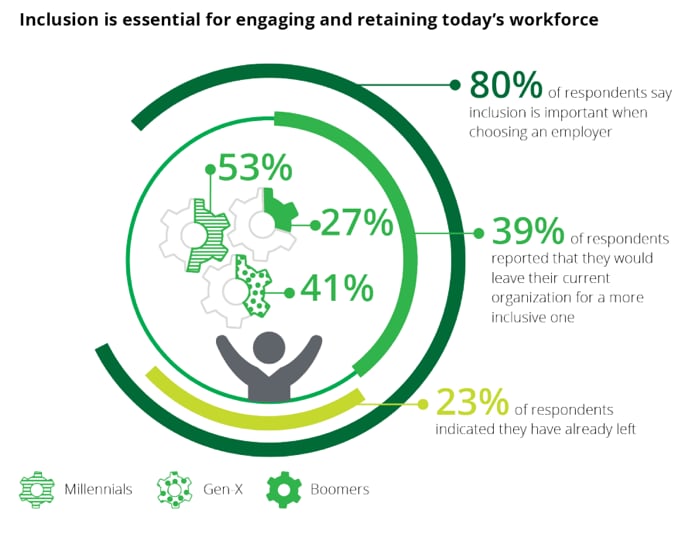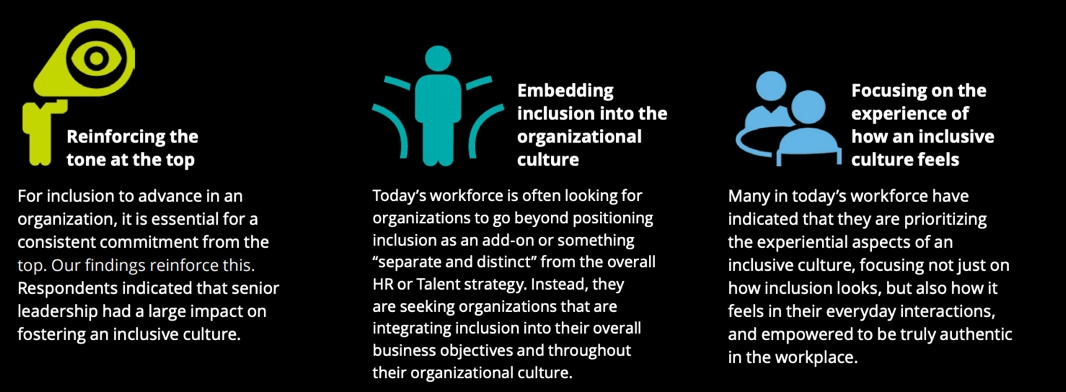Fostering an inclusive culture at work has been saved

Analysis
Fostering an inclusive culture at work
Engaging today’s workforce
Every year, many organizations allocate time, resources, and budget toward efforts to foster an inclusive culture—and interest is still increasing. Given that today’s executives and talent indicate that they view inclusion as a business imperative and critical component of organizational culture, can inclusion affect retention and engagement?
Explore content
- The impact of inclusion on retention and engagement
- Redefining and recommitting to inclusion
- Recommendations for integrating inclusion for today’s workforce
- Get in touch
- Join the conversation
Part 1: The impact of inclusion on retention and engagement
Every year, many organizations allocate time, resources, and budget toward efforts to foster an inclusive culture—and interest is still increasing. Given that today’s executives and talent indicate that they view inclusion as a business imperative and critical component of organizational culture, can inclusion affect retention and engagement?
Our survey of more than 1,300 full-time employees from a range of organizations and industries across the United States suggests the answer is a resounding yes.

Cultivating an inclusive culture is an essential component in talent strategies and can result in increased creativity, productivity, and innovation—and it often starts at the top.
The majority of respondents stated that everyone—their coworkers, themselves, their direct managers, and especially senior leadership—all have a role to play in inclusion. The tone set by senior leaders can have a great impact on workplace culture and employee commitment to their organizations.
Part 2: Redefining and recommitting to inclusion
Even if an organization or a team has a variety of demographic groups and different backgrounds, does that necessarily make it inclusive?
Today’s workforce is looking for organizations to go beyond only addressing how inclusion looks to meaningfully addressing how inclusion feels.
Organizations today often remain fixated on metrics and categorizing individuals by demographic attributes instead of investing in and measuring engagement and experiences. Our survey underlines a continuing disconnect between what today’s workforce is seeking and what organizations are providing.

Most respondents prioritized criteria that reflected the experience of an inclusive culture. Authenticity in particular emerged as a leading factor in career choices. Today’s workforce looks for an environment where they can be themselves. They do not want inclusion to be solely a programmatic initiative or add-on. Rather, inclusion should be a fundamental aspect of their experience and felt throughout everyday aspects and behaviors.
Part 3: Recommendations for integrating inclusion for today’s workforce
Many in today's workforce are seeking organizations where inclusion is rooted in their daily experiences. Additionally, they do not view programs as the only way to foster an inclusive culture. They want to see their leaders and peers demonstrate it in their behaviors. So how can organizations advance inclusion in a meaningful way?

By reinforcing the tone at the top, creating unique ways for individuals to connect across differences to find common ground, and raising levels of awareness around inclusive behaviors, organizations can foster a culture where inclusion is embedded into everyday interactions. This approach reinforces that, in today’s workplace, everyone benefits from—and everyone has a role to play—in fostering an inclusive culture.
Recommendations
Redefining leadership with an inclusive approach
Driving performance with a diverse and inclusive workplace

